Studio Visit
Step Inside Gajin Fujita’s Echo Park Studio, Where the Artist Blends Edo-Era Japanese Imagery With L.A. Street Art
The artist's solo show "True Colors" is currently on view at L.A. Louver.
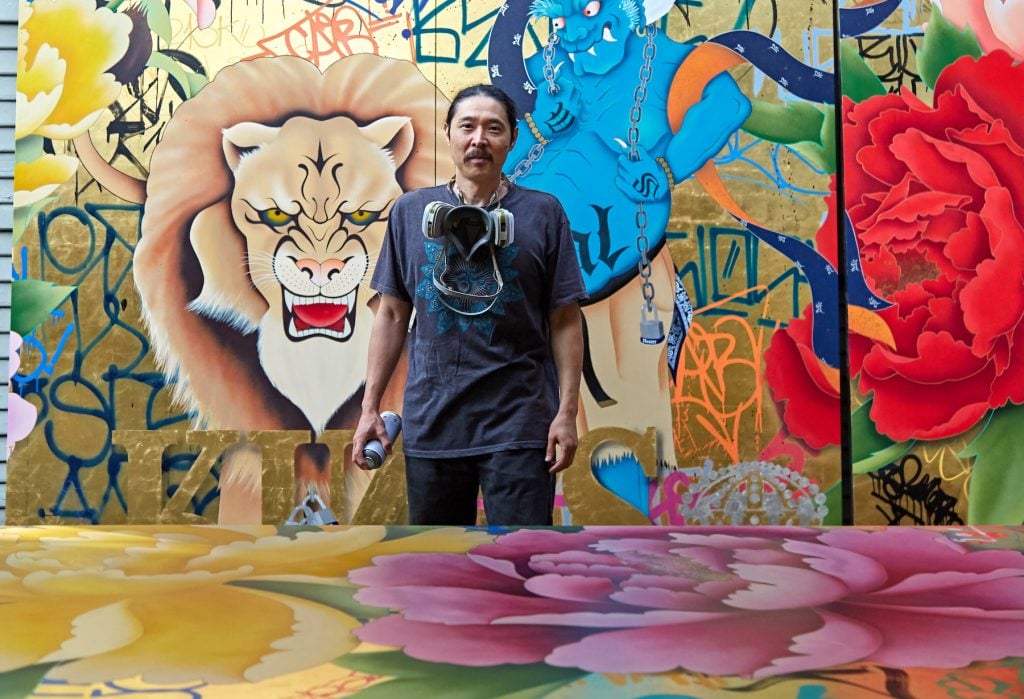
The artist's solo show "True Colors" is currently on view at L.A. Louver.

Katie White

Gajin Fujita is a uniquely Los Angeles artist. Born to Japanese parents, Fujita (b. 1972) came up creatively during the 1980’s and ’90s in two of city’s influential graffiti crews, K2S and KGB. In the decades since, Fujita has defined a distinctive visual language that blends imagery from traditional Japanese culture—think samurai warriors and mythical beasts—with imagery from the city’s own unique culture.
In his current solo exhibition “True Colors” at L.A. Louver, Fujita has created a dynamic world that melds Japanese ukiyo-e figures from the Edo period, including deities and beasts, with scenes pulled from the complexity of our own times. The works are also an homage to his native city. In Home Field LA (2020), the artist’s only self-portrait in the show, the artist is shown looking down on the skyline of downtown L.A. from the house where he grew up, the scene overlaid with patterns of Eastern textiles.
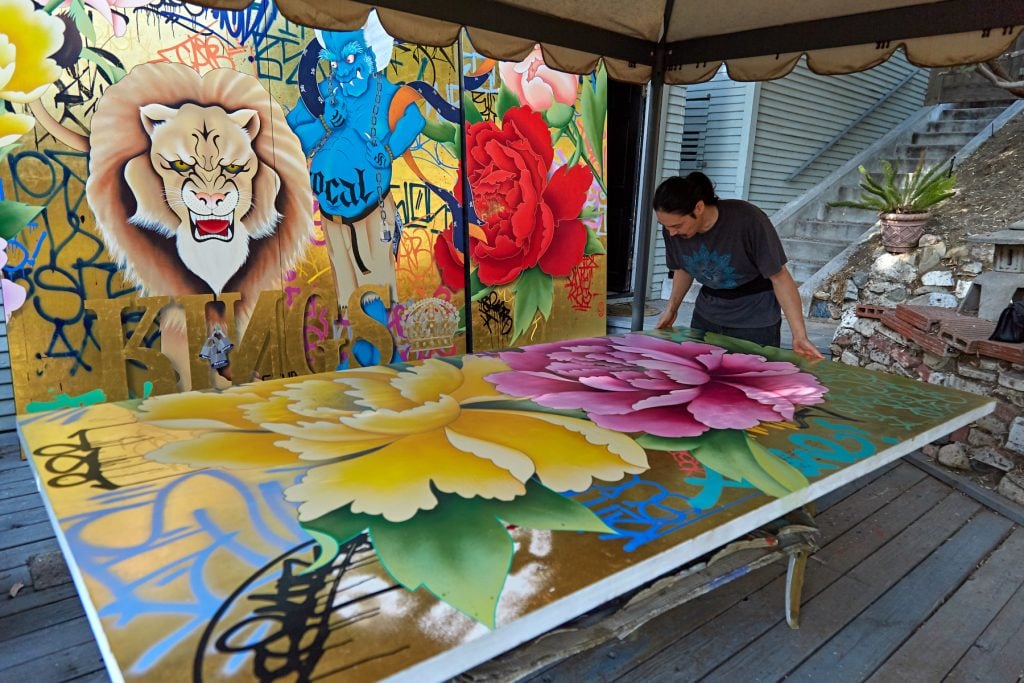
Courtesy of the artist and L.A. Louver.
He creates these multimedia works that blend spray paint, gold leaf, and drawing in his unique workspace—a deck and compact studio in the back of the Echo Park home he shares with his wife, photographer Angela Fujita. In this small space, Fujita stockpiles spray paint, stencils, and a surprising amount of art by the street artists he grew up with.
Recently, he brought us in to his creative space and gave us a glimpse into his creative practice.
Tell us about your studio. Where is it, how did you find it, what kind of space is it?
My studio is in Echo Park, Los Angeles. It’s a tiny, detached building that came with a wooden deck when I got my home in 2012. I do all my spraying out on the deck, and the studio itself is more of a storage space for all my materials. It’s cold during the winters and hot during the summers.
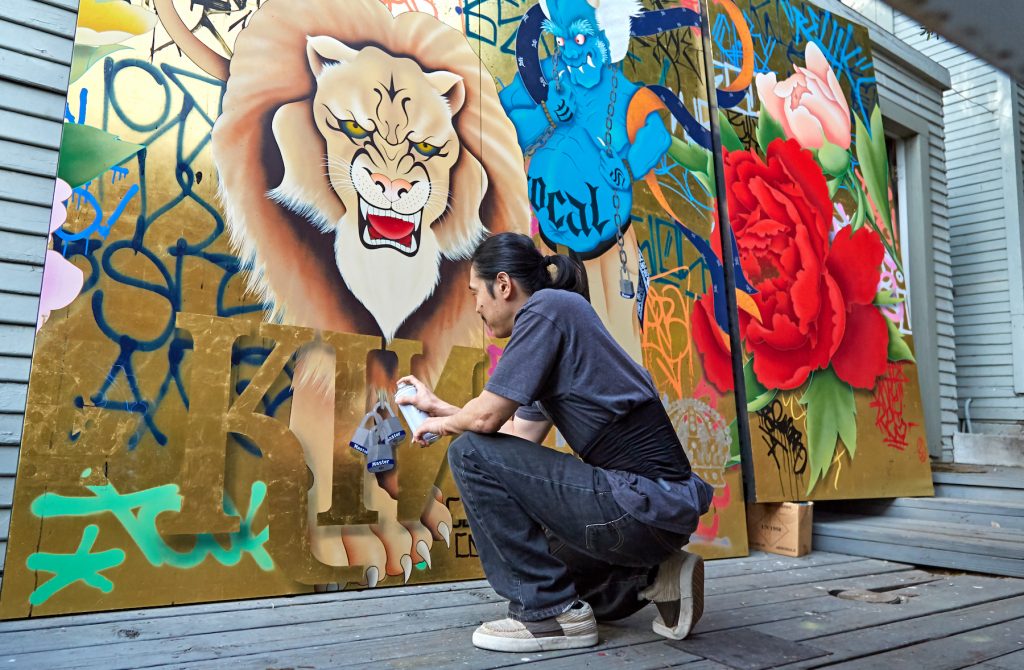
Photo by Angela Fujita, courtesy of the artist and L.A. Louver.
What made you choose this particular studio over others?
I chose this particular spot because I was looking for a home close to downtown, with a large outdoor space where I could work.
Do you have studio assistants or other team members working with you? What do they do?
So, I usually work alone, but on occasion I will have someone like my brother assist me in gilding gold leaf. I also have my fraternity of graffiti crew members come out and add flavor into the paintings with their tags.
How many hours do you typically spend in the studio, what time of day do you feel most productive, and what activities fill the majority of that time?
Typically, I try to put in about 4 to 7 hours in the studio. My prime hours of playing with my paints will be in the afternoon to right before the sun starts to set. I try to fill most of my time in the studio to paint, but there are several different processes that involve making my paintings. There are times I will be working on gilding gold leaf onto the surfaces of the paintings, or at times I would be working on drawings and cutting out stencils in preparation to paint.
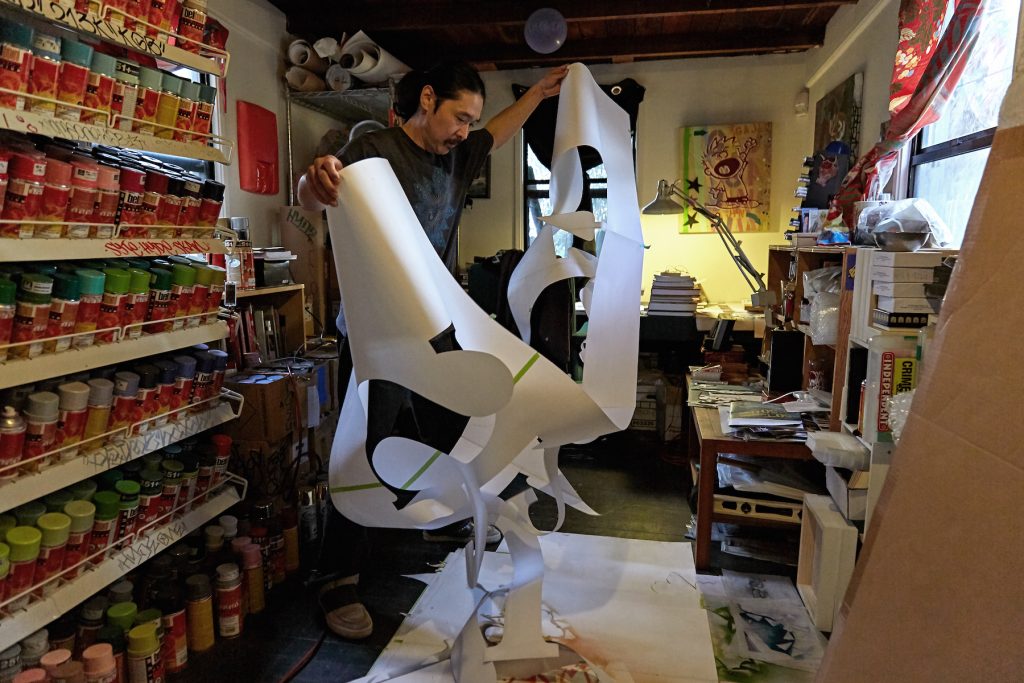
Photo by Angela Fujita, courtesy of the artist and L.A. Louver.
What is the first thing you do when you head to your studio?
I usually turn on some music after opening my studio. I’ve been listening to old hip hop radio shows, specifically the Stretch & Bobbito shows from the ‘90s. It was a show that came on after midnight on Thursday nights on WKCR 89.9 NYC. Lots of hip hop band mixtapes from the ‘90s like A Tribe Called Quest to the DITC. I like mixtapes because they’re continuous music for over an hour or more, so it doesn’t cause any interruption during work.
What is a studio task on your agenda this week that you are most looking forward to?
I’m always looking forward to painting or playing with paints and colors! Also preparing the stencils, cutting out the paper stencils with the X-Acto knife. After preparing the stencil I love handling the spray paint and actually making color choices spraying these colors with the use of the stencil. I also love to see the results of what I painted and the revealing phase of when you pull the stencil off the surface.
What tool or art supply do you enjoy working with the most, and why? Please send us a snap of it.
I like my spray paints, they’re like a basketball to a basketball player.
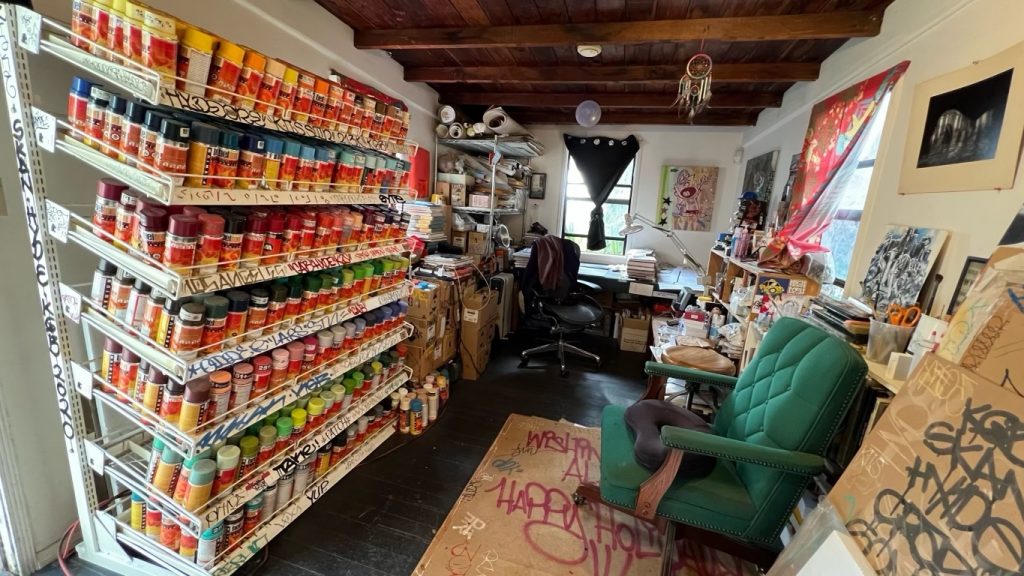
Photo by Angela Fujita, courtesy of the artist and L.A. Louver.
What kind of atmosphere do you prefer when you work? Is there anything you like to listen to/watch/read/look at etc. while in the studio for inspiration or as ambient culture?
Atmospherically, I like to be by myself and will have some sort of hip hop mix bumping while I paint. And when I’m in the studio I like reading and looking through books of Ukiyo-e woodblock print masters. Also, sometimes I just like listening to what’s going on in the environment surrounding me.
How do you know when an artwork you are working on is clicking? How do you know when an artwork you are working on is a dud?
I try to approach my paintings with a composition that’s planned in advance, so when I start painting, I’m working on something that’ll click and transpire into my vision.
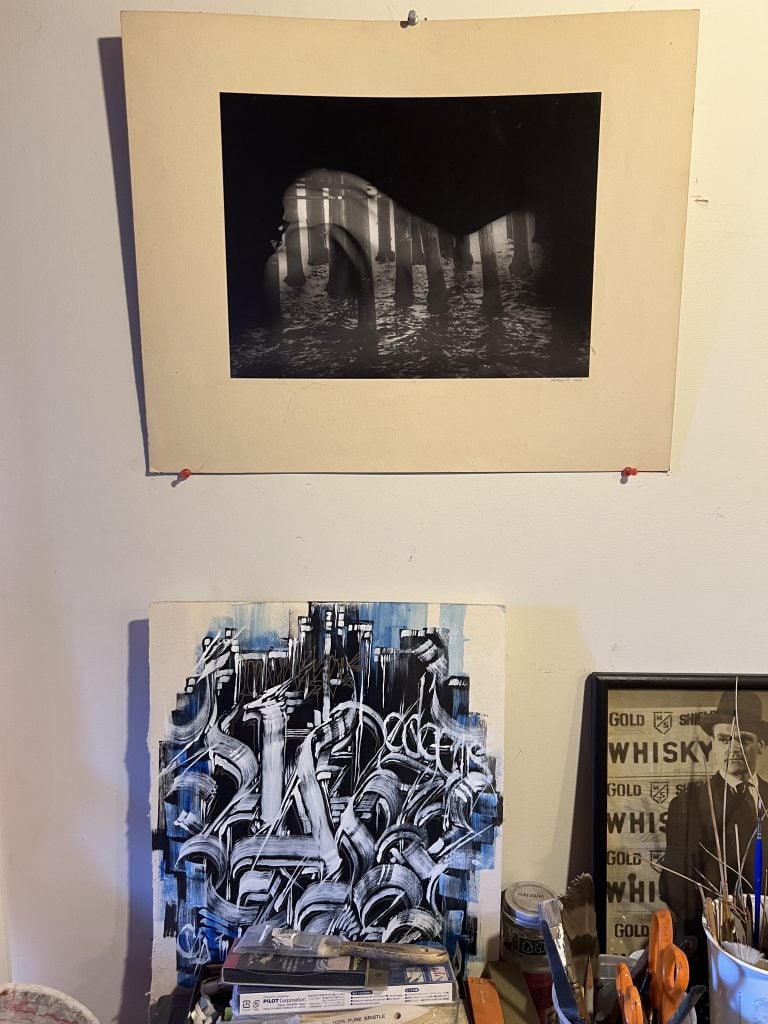
A black-and-white photograph by Angela Fujita, above a painting by the artist’s friend, Alex “Defer” Kizu. Photo by Angela Fujita, courtesy of the artist and L.A. Louver.
What images or objects do you look at while you work? Do you have any other artist’s work in your studio? If so, please share a phone pic and tell the story behind it.
I look at a lot of colors with the spray paints I have in my studio. Also I do have a few of my friends’ artworks on the walls and in the studio. I have a work by Jesse Simon, my old friend from middle school who is also a member of KGB graffiti crew, and another by Kevin Bays, who was my classmate in graduate school. I also have a work by graffiti artist Miner WCA, and a painting by CAB K2S, an old childhood friend from the neighborhood of Boyle Heights. Next to CAB’s painting is an image of the LA Public Library card I collaborated with them on in 2019 using the image of my painting Guardian Angel (2016). There is also a photo on the wall taken and printed by my wife Angela Lee Fujita in 1992. It is a double exposure with one of the exposures being my torso. Lastly, there’s a painting leaning against a wall by an old friend and artist from middle school, Alex “Defer” Kizu. Defer is a member from the K2S graffiti crew. He painted this painting spontaneously and impulsively on a thick piece of watercolor paper.
What’s the last museum exhibition or gallery show you saw that really affected you and why?
The last shows that had a huge effect on me were the Caravaggio and the Japanese armor shows that I saw at LACMA. With Caravaggio, I was just in awe to be standing in front of these paintings created by one of my heroes more than 400 years ago. With the Japanese armor show, I was fascinated how these armors made for Japanese warriors 500 years ago were made with not only protective designs in mind but had a lot of aesthetics and creative designs implied—as well with great craftsmanship.